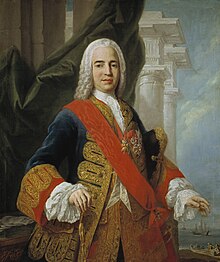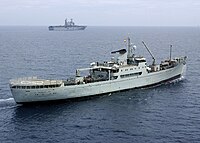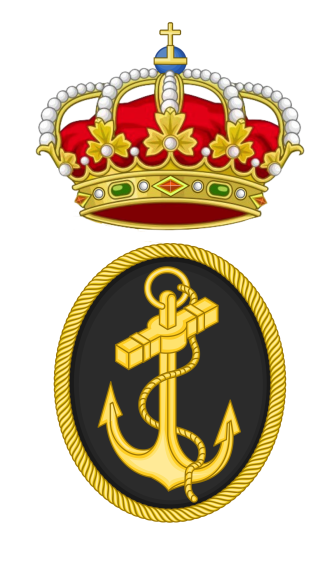
The Spanish Navy or officially, the Armada, is the maritime branch of the Spanish Armed Forces and one of the oldest active naval forces in the world. The Spanish Navy was responsible for a number of major historic achievements in navigation, the most famous being the discovery of America and the first global circumnavigation by Elcano. For several centuries, it played a crucial logistical role in the expansion and consolidation of the Spanish Empire, and defended a vast trade network across the Atlantic Ocean between the Americas and Europe, and the Manila Galleon across the Pacific Ocean between the Philippines and the Americas.
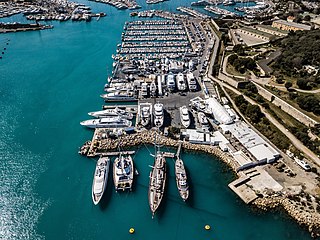
A shipyard, also called a dockyard or boatyard, is a place where ships are built and repaired. These can be yachts, military vessels, cruise liners or other cargo or passenger ships. Compared to shipyards, which are sometimes more involved with original construction, dockyards are sometimes more linked with maintenance and basing activities. The terms are routinely used interchangeably, in part because the evolution of dockyards and shipyards has often caused them to change or merge roles.
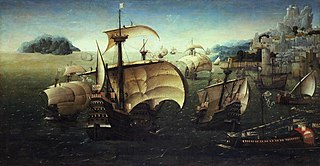
A carrack is a three- or four-masted ocean-going sailing ship that was developed in the 14th to 15th centuries in Europe, most notably in Portugal and Spain. Evolved from the single-masted cog, the carrack was first used for European trade from the Mediterranean to the Baltic and quickly found use with the newly found wealth of the trade between Europe and Africa and then the trans-Atlantic trade with the Americas. In their most advanced forms, they were used by the Portuguese for trade between Europe and Asia starting in the late 15th century, before eventually being superseded in the 17th century by the galleon, introduced in the 16th century.
Navantia is a Spanish state-owned shipbuilding company that builds vessels for the military and civil sectors. It is the fifth-largest shipbuilder in Europe and the ninth-largest in the world. The company is the result of the segregation of the military assets of the IZAR Group in 2005. The company designs, builds, and supports all types of surface vessels, submarines, and systems. In addition, it is diversifying into new markets such as renewable energy, the offshore industry, and naval services.

The Cockatoo Island Dockyard was a major dockyard in Sydney, Australia, based on Cockatoo Island. The dockyard was established in 1857 to maintain Royal Navy warships. It later built and repaired military and battle ships, and played a key role in sustaining the Royal Australian Navy. The dockyard was closed in 1991, and its remnants are heritage listed as the Cockatoo Island Industrial Conservation Area.
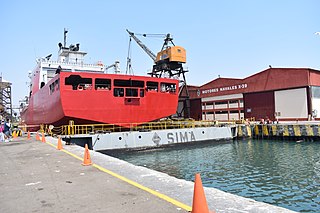
Servicios Industriales de la Marina S.A., well known as SIMA or SIMA PERU S.A., is a Peruvian shipyard that operates as a state owned company established under private law in 1950 pursuing the activities of the former Naval Factory founded in 1845, and continually extending its operational capacity, first to the shipbuilding which SIMA pioneered in South America and then to the greatest metalworking structures manufacture, contributing to the defense and socio-economic development of Peru. The SIMA mainly serve the Navy of Peru as well as domestic and foreign private clients through a wide range of products.

The military port of Toulon is the principal base of the French Navy and the largest naval base in the Mediterranean, situated in the city of Toulon. It holds most of France's force d'action navale, comprising the aircraft carrier Charles de Gaulle as well as its nuclear attack submarines, in total, the base contains more than 60% of the French Navy's tonnage, and about 20,000 military and civilian personnel work at the base.
Peral was the first successful full electric battery-powered submarine, built by the Spanish engineer and sailor Isaac Peral for the Spanish Navy, in Arsenal de la Carraca. The first fully capable military submarine, she was launched 8 September 1888. She had one torpedo tube and an air regeneration system. Her hull shape, propeller, periscope, torpedo launcher and cruciform external controls anticipated later designs. Her underwater speed was 3 knots. With fully charged batteries, she was the fastest submarine yet built, with underwater performance levels that matched those of First World War U-boats for a very short period, before her batteries began to drain. For example, the SM U-9, a pre-war German U-boat built in 1908, had an underwater speed of 8.1 knots, and an underwater range of 150 km (81 nmi) at 5.8 knots, before having to resurface to recharge her batteries. Although advanced in many ways, Peral lacked a means of charging batteries while underway, such as an internal combustion engine, thus had a very limited endurance and range. In June 1890, Peral's submarine launched a torpedo while submerged. It was also the first submarine to incorporate a fully reliable underwater navigation system. However, conservatives in the Spanish naval hierarchy terminated the project despite two years of successful tests. Her operational abilities have led some to call her the first U-boat.
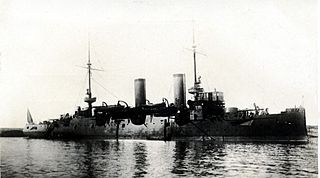
The Princesa de Asturias class was a class of armoured cruisers of the Spanish Navy during the late 19th and early 20th centuries. The class comprised three ships, Princesa de Asturias, Cataluña and Cardenal Cisneros. With construction beginning on the lead ship of the class in 1890, it was considered to be essentially a repeat of the three Infanta Maria Teresa-class cruisers but with more modern and balanced armament. Cardenal Cisneros was wrecked in 1905 but the fate of the other two ships of the Princesa de Asturias class is unknown.

The Arsenal de Marinha do Rio de Janeiro (AMRJ) is a military organization of the Brazilian Navy. It is located in Ilha das Cobras, at the Guanabara Bay, in the city of Rio de Janeiro. The Arsenal is the main maintenance center and naval base of the Brazilian Navy, involving the design, construction and maintenance of ships and submarines, not only for the Brazilian Navy, but also friendly nations.

The Spanish Republican Navy was the naval arm of the Armed Forces of the Second Spanish Republic, the legally established government of Spain between 1931 and 1939.
The San Fernando Naval Museum is a naval museum located in San Fernando in the Province of Cádiz, Andalusia, Spain. Although a naval museum was called for as early as 28 September 1792. A museum was established in 1843, but the current museum was inaugurated on 27 March 1992, with the main purpose to promote the history of the presence of the Spanish Armada in the area.

The navy of the Order of Saint John, also known as the Maltese Navy after 1530, was the first navy of a chivalric order. It was established in the Middle Ages, around the late 12th century. The navy reached its peak in the 1680s, during the reign of Grand Master Gregorio Carafa. It was disbanded following the French invasion of Malta in 1798, and its ships were taken over by the French Navy.
The Real Astillero de Esteiro was a royal shipyard in Ferrol in Spain. Orders for its construction were issued by Ferdinand VI of Spain on 9 April 1749, following the decision by the naval minister Zenón de Somodevilla, 1st Marqués de la Ensenada, to build new naval fortifications and installations in Ferrol and its surrounding area. Initial construction was managed by Cosme Álvarez, Comandante General of the Department. It was sited on the northwest slope of the monte Esteiro near Ferrol. It was initially planned to have four levels, but by the end this rose to twelve, proportional to the mountain's slope. Barracks, workshops and warehouses were also built.

Audaz (P-45) is an offshore patrol vessel and the fifth of the Meteoro class created for the Spanish Navy. It is the fourth Navy ship to carry this name. The patrol vessel was built in the Navantia's shipyard in San Fernando.

The Cartagena Naval Base, also known as Arsenal of Cartagena, is a military base and arsenal of the Spanish Navy located in the city of Cartagena. It is one of the oldest naval bases in Spain, having been created in the 18th century. Located in the southeast of the Iberian Peninsula, it is the main Spanish base in the Mediterranean Sea.

Ferrol Naval Base also known as the Arsenal of Ferrol is a military base and arsenal of the Spanish Navy located in Ferrol, Spain. It is the main Spanish naval base on the Atlantic.

The Royal Arsenal of Havana was located South East of the Campo de Marte and played a prominent role in Spanish shipbuilding in the 18th century. In total, seventy-four warships were built in Havana during this century.
San Leandro was a 64-gun San Fulgencio-class ship of the line built for the Royal Spanish Navy in the 1780s.

